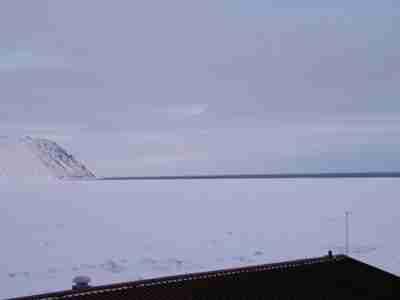
|
|
8 March, 2002

In this picture, the northern tip of Big Diomede is evident in the upper left hand corner looking north towards open water. By arctic standards the weather has been unseasonable warm and mild in the time that Dr. Jolles and I have been here. The temperature today has been around 8 degrees Fahrenheit, with mild winds coming from the South and east. When wind blows from the North, it is much colder bringing the icy temperatures from the far north, across the Arctic Ocean and into the strait. As I understand it, the sea ice that has frozen between Big and Little Diomede does not just form, it actually comes from the North, carried along by winds and then catching and forming between the two islands. The ice "comes in," blown by the winds, colliding with the existing sea ice that temporarily connects the two islands, and changing the landscape continually. When the winds have been blowing from the South, the weather can be much wetter and more foggy, and some of the ice is blown north again, exposing open water. These pockets of open water provide breathing holes for many marine mammals and are fertile hunting grounds for both human and polar bear hunters in search of food. This area of open water and ice is also very unstable, with leads/cracks that can shift, crack off, open up and close in again without notice.

I find it fascinating to hear people speak of when the ice "...comes in..." and "...goes out..." and in fact, that is exactly what happens. Little Diomede is situated in the Bering Strait in a type of corridor between the Arctic Ocean and Chukchi to the North, and the Bering Sea to the South. The ice, and much of the animal life that people here depend on, literally "comes in," floating from the North. The sea ice blows in from the North, colliding with the existing sea ice that temporarily connects the two islands, and changing the landscape continually. I've been told that during the spring and fall harvest seasons when many marine mammals are migrating, you can quite literally see whales, walrus and other marine mammals pass between the two islands. Orcas or killer whales are not hunted for food, but can be seen swimming past in pods, as can the walrus herds on which they feed, floating though on ice floes towards the South. Here, the sea ice that made crabbing and plane landings possible, is also a playground to a small group of children.
Contact the TEA in the field at
.
If you cannot connect through your browser, copy the
TEA's e-mail address in the "To:" line of
your favorite e-mail package.
|
